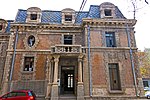Chaonei No. 81 (simplified Chinese: 朝内81号; traditional Chinese: 朝內81號; pinyin: Cháo nèi bāshí yī hào, short for simplified Chinese: 朝阳门内大街81号; traditional Chinese: 朝陽門內大街81號; pinyin: Chāoyáng mén nèi dàjiē bāshí yī hào or Chaoyangmen Inner Street No. 81), sometimes referred to as Chaonei Church, is a house located in the Chaoyangmen neighborhood of the Dongcheng District in Beijing, China. It is a brick structure in the French Baroque architectural style built in the early 20th century, with a larger outbuilding. The municipality of Beijing has designated it a historic building.It is best known for the widespread belief that it is haunted, and it has been described as "Beijing's most celebrated 'haunted house'". Stories associated with the house include ghosts, usually of a suicidal woman, and mysterious disappearances. It has become a popular site for urban exploration by Chinese youth, especially after a popular 2014 3D horror film, The House That Never Dies, was set there.Due to incomplete historical records, there is disagreement about who built the house and for what purpose; however it is accepted that, contrary to one frequently cited legend, the house was never the property of a Kuomintang officer who left a woman, either his wife or a mistress, behind there when he fled to Taiwan in 1949. Since the establishment of the People's Republic of China (PRC) that year, records are more consistent. It was used as offices for various government agencies for most of the PRC's early years. During the Cultural Revolution, in the late 1960s, it was briefly occupied by the Red Guards; their hasty departure from the property has been cited as further evidence of the haunting. It is currently owned by the Roman Catholic Archdiocese of Beijing, which in the late 1990s raised the possibility that it might one day serve as the Vatican embassy as a reason for not demolishing it.The complex has been restored, and it is opened for renting since 2017. The rent of the two buildings may be estimated to around 10 million RMB per year.










